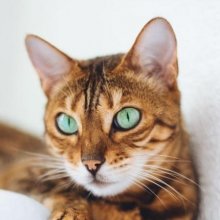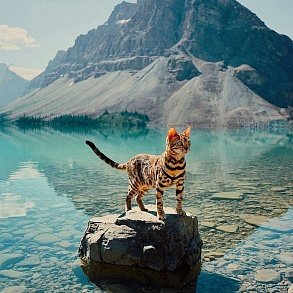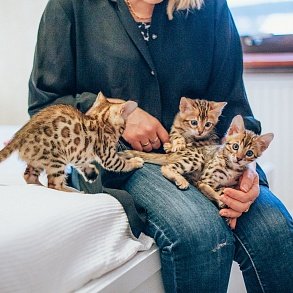Bengal Cat

The Bengal cat is a unique example of successful crossing of wild and domestic breeds. They are active, playful and sociable pets.
Brief information
- Breed name: Bengal cat
- Country of Origin: USA
- Birth time of the breed: 1983
- Weight: 4-9 kg
- Life expectancy: 12-15 years, sometimes up to 21 years
Highlights
- Bengal cats are representatives of an elite breed.
- They are distinguished by their external attractiveness, grace and recognizable color.
- These are loyal and responsive pets who easily adapt to the rules of life in a permanent family and do not show unmotivated aggression.
- are ideal for experienced owners who are ready to pay a lot of attention to the cat and be a companion in active games and walks.
- They stand out among others with a sharp mind, training potential and developed communication skills.
- Clean, appreciate the comfort and friendly atmosphere.
- Animals of this breed are highly appreciated by experts of international exhibitions. So, in the top 25 of the overall rating of the "best cats" according to The International Cat's Association in 2016, there are two Bengals, and a year earlier - four.
Bengal cat is a rather rare and therefore especially valuable specimen. The beauty, strength and grace of large predators are truly fascinating, but, of course, few people would think of keeping a tiger or a panther in an apartment for reasons of humanity and elementary safety. But a small home "leopard" is a very real alternative. The Bengal breed combines the best features of its ancestors: not only attractive appearance, but also intelligence, curiosity, activity, friendliness.
Breed characteristics
History of the Bengal cat breed
As you know, new breeds of domestic cats appear mainly as a result of careful breeding, designed to obtain animals with the desired characteristics of parents of different artificially created species or to consolidate the result of natural mutation. The appearance of the Bengal cat, in fact, was the result of the persistent work of one enthusiast who acted in spite of unfavorable life circumstances and the prejudices of colleagues. The name of this purposeful woman is Jane Mill. While studying at the University of California, Davis, a genetics student was interested in the possibility of creating a new breed by crossing royal Siamese and persian individuals . But the supervisor considered such a research topic "frivolous", advising to focus on breeding something more practical that could interest rural or livestock farms. The idea was abandoned, but not forgotten.
In 1961, during a working trip to Thailand, Jane saw wild leopard cats for the first time and was completely fascinated by these big-eyed creatures. There, a shocked American woman learned that the existence of the species is threatened by hunting for their unusual fur. To save at least one spotted beauty, she bought and brought Malaysia home, where a mongrel black cat already lived. The hostess had no plans to get a common offspring, and the birth of Kin-Kin was a real surprise. The "hybrid" cat, in turn, had two kittens, but it was not possible to continue the line: the girl did not inherit the characteristic color of Far Eastern cats and was distinguished by a bad character, and the boy died by tragic accident. Kin-Kin herself, without bringing any other offspring, died of pneumonia.
The felinologist's experiments could have stopped there, however, by a happy coincidence, litter from domestic cats and male ALC (Asian Leopard Cat) resistant to this disease was obtained at the Loma Linda University Medical Center for feline leukemia research. Dr. Willard Centerval, who led the project, was happy to hand over several first-generation kittens to Jane's care. A new problem was the choice of partners for further breeding – Mrs. Mill was sure that british , abyssinian or other popular species have genetically weakened lines, and therefore are not suitable for breeding a new breed. The solution was found after a trip to New Delhi, where she accidentally saw a spotted golden-red kitten. The bronze color and the special radiance of the Tory coat were passed on to descendants. Later, several more cats were delivered from India to the USA for Jane, today recognized as the "Indian line" mau .
Many local breeders are familiar egyptian mau and ocicets took the initiative with hostility and launched a campaign against the registration of hybrids. It is not known whether they feared an uncontrolled manifestation of "wild blood" or simply tried to prevent the appearance of spotted competitors. As a result, Bengal cats were not recognized by the authoritative The Cat Fanciers for a long time' Association, although TICA registered the first individual of a new breed back in 1983. Since 1985, Jane Mill's pets have actively participated in national exhibitions, conquering experts and spectators with shiny fur with a contrasting pattern, athletic build and natural grace.
Throughout the 80s and 90s, the creator of Bengals continued selective work and received several more productive lines, including with the participation of new males of the leopard cat. Today, breeders call the main goals of improving the breed cleaning from "genetic garbage", which manifests itself in kittens with a monochrome color, long hair, undesirable ticking.
Video: Bengal Cat
Appearance of the breed
Bengal cats have medium or large sizes, but are inferior to the largest domestic breeds like maine coon or savannah . The weight of an adult animal can range from 4 to 9 kg, height at the withers – 26-32 cm, length from nose to tail tip – 65-100 cm. At the same time, males are much larger than females and reach their maximum size by the age of 2. Cats practically stop growing after 9 months.
The main distinguishing feature of the Bengal cat's exterior is undoubtedly its "wild" color, it was this feature that determined the direction of breeding work from the very beginning. Over time, a breed standard was developed and approved, which covers the main features.
Wool
The coat of a Bengal cat is shorter than average (kittens have an acceptable average length), thick, adjacent to the body. A characteristic difference from other breeds is an extraordinary silkiness and a special "inner" shine, called glitter. The latter is inherited from wild ancestors and is extremely valued.
Color
The main requirement for the color of the Bengal cat is the clearest contrast between the spotted or marble pattern and the background. The drawing can have a shade from black to cinnamon, and the background should be in the interval between golden-orange and ivory. Reputable breeders (for example, Gene Dakot) insist that preference should be given not to "red" bengals, whose rosettes and stripes almost merge with the base as they grow up, but to cats with a fawn background and a dark pattern.
Due to the "wild" genes, Bengal kittens have a unique feature of color for domestic cats: being born bright, with a pronounced pattern, they suddenly fade by 3-4 weeks. This is explained by the fact that at this age the offspring of the Far Eastern cat begins to leave a safe haven and without such "tarnishing" will become easy prey for predators. Such fuzzing (from the English fuzzy – blurred, indefinite) lasts about two months, that is, just by the time the kitten is acquired, it becomes attractive again. However, the final color of the cat is set much later, at 8-10 months.
Spotted pattern is more common than marble. They are distinguished from the usual "mackerel" color for other breeds by their location along (and not across) the trunk or diagonally. The shape of the spots can vary widely, the main thing is their clear outlines, while simple single ones are considered undesirable. The marble pattern consists of contrasting stripes curiously twisting in the horizontal direction. A significant disadvantage of any color are white spots – "medallions" on any part of the body. The belly is preferably of a light tone, and the absence of spots on it is a sufficient condition for disqualifying a Bengal cat at an exhibition.
To date, officially accepted variants are brown tabby, silver tabby, sepia tabby seal, mink tabby seal, links point seal and approved only in 2013, and therefore rare blue tabby.
Head
The structure of the Bengal cat's skull belongs to the so-called "wild" type. It has the shape of a modified wedge, rather elongated than wide, the contours are soft, rounded. The line of the occipital part is a continuation of the neck line. In relation to the body, it has a small, but, in general, proportional size.
As for the profile, there are discrepancies in the American and European standard. The first assumes a strictly straight line forming a single arc from the level of the eyebrows, while the second allows for the possibility of a slight bend at the point of transition of the forehead to the nose.
The jaws are powerful. Cheekbones are high, clearly defined. The chin is rounded, located in line with the tip of the nose. Adults may have pronounced cheeks. The nose is large and wide. The whisker pads are convex.
Ears
Continue the wedge line, are characterized by a small size relative to the head, a wide base and rounded tips (most other breeds have pointed tops).
Eyes
The eyes of the Bengal cat are large and expressive. The shape is oval, but close to round. They are placed quite widely and have a deep fit. The color is bright and saturated, most often varies from light green to gold. Cats of the point, mink color have shades of blue and blue from aqua to sapphire. They glow very brightly in the dark.
Neck
Corresponds to the proportions of the head and body. Long, strong, muscular.
Torso
Has a developed musculature, powerful, elongated (but not of the oriental type characteristic of orientals). The backbone is solid and strong. A flattened or underdeveloped chest is a disqualifying disadvantage.
Limbs
Medium length, strong, musculature is developed in proportion to the general constitution of the body, the bones are wide. The rear ones are slightly longer than the front ones. The pads are large, round in shape, the finger joints are slightly protruding.
Tail
The tail of a Bengal cat is of medium length, thick, tapers towards the end and has a rounded tip. Ringed with dark stripes or (less often) covered with small spots.
Photos of Bengal cats
Character of the Bengal cat
Many potential owners are afraid of the possibility of unmanageable character traits that Bengals can get from wild leopard cats. I must say that such fears are groundless if the pet does not belong to the first three generations of the hybrid. Cats F4–F7, raised in conditions of constant contact with humans, are invariably characterized by a balanced and friendly disposition. With an open-air content in the kennel and a lack of attention from the breeder, kittens run wild, but this disadvantage is easy to identify when first meeting with the kids.
Bengals are very social. They easily find a common language with all household members, as for other pets, they peacefully coexist with cats of other breeds, and they are often even friends with dogs. However, we must not forget that Bengal cats have extremely developed hunting instincts, so leaving them alone with potential prey is fraught with tragedy. Protection is required not only for birds and rodents, but also for aquarium fish, because, like Asian ancestors, domestic leopards do not suffer from hydrophobia. Moreover, they get real pleasure from water procedures and can unceremoniously dive into a filling bath or sneak into a working shower stall.
Representatives of the Bengali breed (especially ladies) do not particularly favor invasion of their personal space. No, you will not encounter aggression in response to an attempt to "cuddle", but too close contact makes them feel uncomfortable. It is better to wait until the Bengal has the appropriate mood and he will come to you for affection. But the verbal communication pets meet with great enthusiasm and enthusiastically "support the conversation". In the arsenal of these cats there are many specific sounds and intonations, in a few weeks you will be able to understand what most of these "phrases" mean.
But the main character trait, perhaps, should be considered incredible energy and playfulness, which persists throughout life. It should be taken into account that with a lack of physical activity, a bored Bengal cat can harm your furniture and interior, so you should immediately provide it with a significant number of various toys and devote enough time to mobile entertainment every day.
Education and training
A well-known fact is the high intelligence of Bengal cats. Natural intelligence, cunning and adaptability provided their ancestors with survival in the wild, and houses are a powerful foundation for learning interesting tricks. They are able to carry out simple commands, bring thrown objects (often using not teeth, but dexterous front paws). The observation and ingenuity of Bengals lead to the fact that, without effort on the part of the owners, they learn to use switches, open latches on doors, flush the toilet and even unscrew the taps.
Bengal cats learn the rules of using the toilet quickly and without problems, but they like to dig deep holes, so it is recommended to make sure that the filler level is always high enough.
Care and maintenance
A pleasant surprise for the owners will be the undemanding care of Bengal cats. The features of the wool exclude strong tangling, it is enough to use a special mitten-a carding or a rubber brush every two or three days. Once or twice a month, it is recommended to trim the claws by 2-3 mm. Of course, cats with amputated claws are not allowed to participate in exhibitions.
It is advisable to brush your teeth with a special paste from time to time. The ears must be carefully treated when dirt appears. Washing a cat that loves water will not be difficult. The main thing is to do this not too often (but, of course, after each walk) and using vet-approved funds.
Recommendations for feeding Bengals do not differ from the accepted standards. The best option is premium industrial feed, which maintains an ideal balance of nutrients, vitamins and trace elements. Combine them with other foods should not be. A natural diet, if you are a supporter of it, should consist of 80-85% meat (chicken, veal, rabbit, lamb) and offal. Keep in mind that dishes from the master's table can provoke serious problems with the gastrointestinal tract.
Bengal cats prefer fresh running water, so it's better to buy a special "fountain" right away.
Health and diseases of the Bengal cat
The comparative youth of the breed and the presence of strong "wild" blood allow us to state the good health of Bengal cats who grew up in normal conditions. The only weak point is the stomach, but a balanced diet easily solves this problem.
How to choose a kitten
Let us remind you once again: the Bengal cat is an elite, and therefore an expensive breed. Do not look for ads for the sale of kittens on random sites or, moreover, buy an animal at the "bird market". Only reliable kennels or breeders with an excellent reputation can guarantee that your pet will be a real Bengal with a reliable pedigree!
When buying a kitten, pay attention to
- registration documents, pedigree and the generation indicated in it (the optimal indicator is F4-F7);
- age – responsible breeder does not offer customers kittens younger than 10-12 weeks;
- weight – at the specified age, a normally developing baby weighs about a kilogram;
- playfulness – a healthy animal should never be sluggish;
- contact – little Bengals should be accustomed to hands, otherwise you risk getting a wild pet;
- clean and clear eyes, no runny nose and signs of diarrhea;
- documents on vaccination;
- the condition of the coat and the absence of visible color defects (important if the Bengal cat is going to participate in exhibitions).
Photos of Bengal kittens
How much does a Bengal cat cost
The price of purebred Bengal kittens in nurseries in Russia starts from $150 and can reach $1500. The specific figure depends on the pedigree and color. Rare and therefore the most expensive are, perhaps, blue tabby kittens.
In addition, each animal is assigned a certain class based on expert evaluation:
- pet class - the so–called "pets for the soul", due to strong deviations from the standard are not allowed in breeding and exhibitions, the cost is from $150 to $300;
- breed class – animals with minor deviations from the standard, the cost is from $300 to $400 without the possibility of breeding and $600-$700 if you want to get such a right;
- show class is an elite among the elite, such cats are recognized as promising for exhibitions, because their cost starts from $500 without the possibility of breeding and from $800 – with such.


